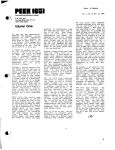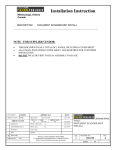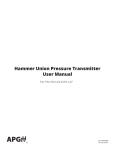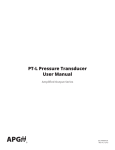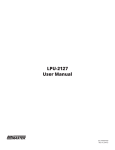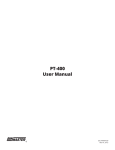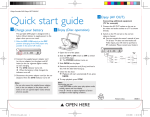Download LPU-2127 User Manual - Automation Products Group, Inc.
Transcript
LPU-2127 User Manual APG R Doc #9002657 Rev B, 01/15 Table of Contents Introduction................................................................................................................. iii Warranty and Warranty Restrictions..................................................................... iv Chapter 1: Specifications and Options..................................................................... 1 Dimensions.........................................................................................................................................1 Specifications.................................................................................................................................... 2 Chapter 2: Installation and Removal Procedures and Notes...............................3 Tools Needed...................................................................................................................................... 3 Installation Notes............................................................................................................................. 3 Mounting Instructions.................................................................................................................... 4 Electrical Installation...................................................................................................................... 4 Removal Instructions...................................................................................................................... 4 Chapter 3: Set Up and Operation...............................................................................4 User Interface................................................................................................................................ 4-5 Operation Modes........................................................................................................................... 6-7 Calibration Modes..........................................................................................................................7-8 Utility Modes................................................................................................................................. 8-9 Chapter 4: Maintenance..............................................................................................9 General Care....................................................................................................................................... 9 Troubleshooting.............................................................................................................................. 10 Calibration........................................................................................................................................ 10 Repair and Returns..........................................................................................................................11 Chapter 5: Hazardous Location Drawing and Certification............................... 12 Hazardous Location Drawing....................................................................................................... 12 CSA Certificate of Compliance................................................................................................ 13-16 ii Tel: 1/888/525-7300 • Fax: 1/435/753-7490 • www.apgsensors.com • [email protected] Introduction Thank you for purchasing a LPU-2127 ultrasonic sensor from APG. We appreciate your business! Please take a few minutes to familiarize yourself with your LPU-2127 and this manual. The LPU-2127 loop-powered ultrasonic sensor provides a low-power, non-contact level measurement solution rated for hazardous locations and suitable for harsh chemical environments. It offers a built-in keypad and four digit LCD display for easy setup, and a NEMA 4X cover for outdoor applications. Reading your label Every APG instrument comes with a label that includes the instrument’s model number, part number, serial number, and a wiring pinout table. Please ensure that the part number and pinout table on your label match your order. The following electrical ratings and approvals are also listed on the label. Please refer to the Certificate of Compliance at the back of this manual for further details. Electrical ratings Input: 12 to 28 Volts DC; Output: 4-20mA Class I Division 2; Groups C, D T6 Class I, Zone 2, Group IIB AEx nA IIB T6: Ta: -40°C to 60°C; IP65 Ex nA IIB T6: Ta: -40°C to 60°C; IP65 IMPORTANT: The LPU-2127 must be installed as shown on drawing 9002745 to meet listed approvals. Faulty installation will invalidate all safety approvals and ratings. Tel: 1/888/525-7300 • Fax: 1/435/753-7490 • www.apgsensors.com • [email protected] iii Warranty and Warranty Restrictions APG warrants its products to be free from defects of material and workmanship and will, without charge, replace or repair any equipment found defective upon inspection at its factory, provided the equipment has been returned, transportation prepaid, within 24 months from date of shipment from factory. THE FOREGOING WARRANTY IS IN LIEU OF AND EXCLUDES ALL OTHER WARRANTIES NOT EXPRESSLY SET FORTH HEREIN, WHETHER EXPRESSED OR IMPLIED BY OPERATION OF LAW OR OTHERWISE INCLUDING BUT NOT LIMITED TO ANY IMPLIED WARRANTIES OF MERCHANTABILITY OR FITNESS FOR A PARTICULAR PURPOSE. No representation or warranty, express or implied, made by any sales representative, distributor, or other agent or representative of APG which is not specifically set forth herein shall be binding upon APG. APG shall not be liable for any incidental or consequential damages, losses or expenses directly or indirectly arising from the sale, handling, improper application or use of the goods or from any other cause relating thereto and APG’s liability hereunder, in any case, is expressly limited to the repair or replacement (at APG’s option) of goods. Warranty is specifically at the factory. Any on site service will be provided at the sole expense of the Purchaser at standard field service rates. All associated equipment must be protected by properly rated electronic/electrical protection devices. APG shall not be liable for any damage due to improper engineering or installation by the Purchaser or third parties. Proper installation, operation and maintenance of the product becomes the responsibility of the user upon receipt of the product. Returns and allowances must be authorized by APG in advance. APG will assign a Return Material Authorization (RMA) number which must appear on all related papers and the outside of the shipping carton. All returns are subject to the final review by APG. Returns are subject to restocking charges as determined by APG’s “Credit Return Policy”. iv Tel: 1/888/525-7300 • Fax: 1/435/753-7490 • www.apgsensors.com • [email protected] Chapter 1: Specifications and Options • Dimensions 4.00" 101.6 mm 6.05" 153.7 mm 2.40" 60.96 mm 2" NPT 2.30" 58.42 mm 2.00" 50.80 mm 5.50" 139.7 mm Tel: 1/888/525-7300 • Fax: 1/435/753-7490 • www.apgsensors.com • [email protected] 1 • Specifications Performance Operating Range 1 - 25 ft. (0.3 - 7.6 m) on liquids and hard, flat surfaces 1 - 10 ft. (0.3 - 3 m) on bulk solids Analog Output 4-20 mA Beam Pattern 9° off axis Frequency69 kHz Response Time 0.6 - 3 seconds (dependent on output range) Sample Rate 3 seconds @ 4 mA 0.6 seconds @ 20 mA Accuracy Accuracy±0.25% of detected range Resolution0.1 inch (2.54 mm) Environmental Operating Temperature -40 to 60°C (-40 to 140°F) Internal Temperature Compensation Yes Enclosure ProtectionIP65 NEMA rating4X Electrical Supply Voltage (at sensor) 12-28 VDC Current Draw22 mA max Output Signal3-30 mA max Load Resistence 150Ω max @ 12 VDC 600Ω max @ 24 VDC Cable Connection2-terminal connector Masterials of Construction Transducer HousingPVDF (Kynar®) Upper HousingPET 2 Tel: 1/888/525-7300 • Fax: 1/435/753-7490 • www.apgsensors.com • [email protected] Chapter 2: Installation and Removal Procedures and Notes • Tools Needed Tools are not necessary for installing the LPU itself. If you are using a stand pipe to mount your LPU, you will probably need tools to install the stand pipe, but not for the LPU. • Installation Notes • Mount your LPU sensor so that it has a clear, perpendicular sound path to the surface being monitored. Your sensor should be mounted away from tank or vessel walls and inlets. See Figure 2.1. • The sound path should be free from obstructions and as open as possible for the 9° off axis beam pattern. • If you are using a stand pipe, please see our guide to stand pipes on our website: http://www.apgsensors.com/about-us/blog/how-to-install-a-stand-pipe. Figure 2.1 NOTE: Do not mount the sensor where the beam will intersect objects such as fill streams, pipes, ladder rungs, wall seams, or corrugated tank walls. Tel: 1/888/525-7300 • Fax: 1/435/753-7490 • www.apgsensors.com • [email protected] 3 • Mounting Instructions Mounting your LPU is easy if you follow a few simple steps: • Never over-tighten the sensor. • Always screw in your sensor by hand to avoid cross-threading. Thread failure can be a problem if you damage threads by over-tightening them or by crossing threads. IMPORTANT: Do not over tighten! The sensor should be threaded in only hand tight. • Electrical Installation • • • • • With the lid of your LPU closed, remove the cable knock out. Clear the flashing. Open the lid of your LPU and intall cable gland or conduit connection. Connect 12-28 VDC supply wire to (+) Terminal Connect 4-20 mA output wire to (-) Terminal. • Removal Instructions • Remove the sensor and store it in a dry place, at a temperature between -40° F and 180° F. Chapter 3: Set Up and Operation • User Interface The LPU display and programming buttons can be accessed by loosening the screw that secures and seals the sensor’s lid. The LCD display shows the distance measurement. The display is also used to view the individual modes and their values when programming. The LPU controls operate similar to a digital wrist watch. The LPU has four buttons, MODE UP, MODE DOWN, VALUE UP, and VALUE DOWN (See Figure 3.1). The MODE UP/DN buttons allow the user to select the desired mode while VALUE UP/DN buttons allow the user to view and alter the settings. To select a mode, press the MODE UP or MODE DOWN button until the desired mode is displayed. Press the VALUE UP or VALUE DOWN button once to view the current setting of that mode. To change the selected mode setting, press the VALUE UP or VALUE DOWN button until the desired value is displayed. 4 Tel: 1/888/525-7300 • Fax: 1/435/753-7490 • www.apgsensors.com • [email protected] To STORE or SAVE the changed mode value, press the MODE UP or MODE DOWN button once. At this point, the display will show the distance measurement. The values are stored in a nonvolatile memory, and will not be lost when power is turned off. Figure 3.1 Along with the buttons and the display, the LPU-2127 includes a detected signal strength indicator. On the leftside of the display are bars to indicate the strength of the signal returning to the sensor (See Figure 3.2). Three bars indicates excellent signal strength; two bars indicates good signal strength; one bar indicates fair signal strength; no bars indicates loss of echo (no signal). Figure 3.2 Tel: 1/888/525-7300 • Fax: 1/435/753-7490 • www.apgsensors.com • [email protected] 5 • Operation Modes MODEDESCRIPTION PARAMETERS 1 Units Range = 0-2 Default = 0 0 = feet 1 = inches 2 = mm Mode 1 is used to select the units of measurement that will be used throughout the setup process and also for display. The units will also determine the resolution of the display and the outputs. The resolution is: feet 0.01, inches 0.1, and millimeters 1. NOTE: All modes must be set using the units selected in Mode 1. MODEDESCRIPTION PARAMETERS 2 4 mA distance Units = Mode 1 Range = 0-9999 Default = 1.00 ft. Mode 2 sets the 4 mA distance, measured from the Zero Point (See mode 10). MODEDESCRIPTION PARAMETERS 3 20 mA distance Units = Mode 1 Range = 0-9999 Default = 25.00 ft. Mode 3 sets the 20 mA distance, measured from the Zero Point (See mode 10). For Distance configuration (i.e., greater mA output for target surface further from sensor), set the mode 2 distance to be less than the mode 3 distance (See Figure 3.3). For Fill configuration (i.e., greater mA output for target surface closer to sensor), set the mode 2 distance to be greater than the mode 3 distance (See Figure 3.4). 20 ma 20 ma 4 ma Zero Point 4 ma mode 2 mode 3 Max. Distance Figure 3.3 6 Zero Point mode 3 mode 2 Max. Distance Figure 3.4 Tel: 1/888/525-7300 • Fax: 1/435/753-7490 • www.apgsensors.com • [email protected] MODEDESCRIPTION PARAMETERS 4 Response Time Range = 1-3 Default = 1 1 = 3.3 ft/min (1m/min) 2 = 15ft/min (4.5m/min) 3 = >15 ft/min (4.5/min) Mode 4 is used to select the desired response time of the sensor. The response time represents the maximum rate of change in target level that the sensor will accurately display. Thus, setting 1 (3.3 ft/min) is the slowest setting, and setting 3 ( >15 ft/min) is the fastest. MODEDESCRIPTION PARAMETERS 5 Fail-safe Range = 0 - 2 Default = 1 0 = hold last 1 = 22 mA 2 = 3.75 mA Mode 5 sets the output condition that the sensor will revert to in the event of a loss of echo condition. If this mode is set to 0, the sensor will hold the last reading until the signal is regained. If set to 1, the output of the sensor will go to 22 mA. If set to 2, the output will go to 3.75 mA. MODEDESCRIPTION PARAMETERS Fail-safe Units = Seconds 6 Delay Range = 5-9999 Default = 15 Mode 6 sets the delay, in seconds, before the output will show a loss of echo condition set in Mode 5. When this time has expired, the display and output will change to their fail-safe settings. NOTE: Most applications do not require the user to manipulate modes beyond 6. • Calibration Modes MODEDESCRIPTION PARAMETERS 7 4 mA Trim Range = 0-9999 Default = 5000 Mode 7 fine tunes the minimum current sourced on the analog output. MODEDESCRIPTION PARAMETERS 8 20 mA Trim Range = 0-9999 Default = 5000 Mode 8 fine tunes the maximum current sourced on the analog output. MODEDESCRIPTION PARAMETERS 9 Calibration Range = 0-1999 Default = 1000 Mode 9 is used to calibrate the sensor for variations in the speed of sound due to variations in atmospheres. The default of 1000 is used for most applications. Assume a decimal after the first digit. Tel: 1/888/525-7300 • Fax: 1/435/753-7490 • www.apgsensors.com • [email protected] 7 MODEDESCRIPTION PARAMETERS 10 Distance Offset Units = Mode 1 Range = -3.00 to 3.00 Default = 0 Mode 10 is used to change the Zero Point of the sensor. This not the zero output (4 mA) point of the sensor. The Zero Point of the sensor is the point from which the calculated distance is measured. See Figures 3.3 and 3.4 on page 6. • Utility Modes MODEDESCRIPTION PARAMETERS 11 Temperature Range = 0 - 2 Compensation Default = 1 0 = OFF 1 = ON 2 = View Temperature (degrees C)/ON Mode 11 activates or deactivates the internal temperature compensation circuit. The speed of sound changes with changes in temperature, therefore changes in temperature can affect distance measurements. These affects can be minimized by activating temperature compensation. If the mode is exited while viewing temperature, temperature compensation is turned ON. MODEDESCRIPTIONPARAMETERS 12 AutoSense Range = 0 - 1 Default = 1 0 = Manual (user controls Sensitivity and Pulses) 1 = AutoSense (sensor controls Sensitivity and Pulses) Mode 12 activates or deactivates AutoSense. When operating with this mode active, the LPU-2127 will automatically change the sensitivity and pulses to match the application. Modes 13 and 15 limit the maximum level that sensitivity and pulses can be manipulated when operating in AutoSense. Modes 13 and 15 set the sensitivity and pulses when operating in manual mode. MODEDESCRIPTIONPARAMETERS 13 Sensitivity Range = 0 - 100% Default = 100% Mode 13 sets the level of gain that is applied to the echo. When operating in AutoSense, this parameter limits the gain that can be applied to the echo. If operating in manual, this parameter sets the receive gain. When in manual mode, set the sensitivity to the minimum value that will allow the target to be reliably tracked through the full range of expected environmental conditions. 8 Tel: 1/888/525-7300 • Fax: 1/435/753-7490 • www.apgsensors.com • [email protected] MODEDESCRIPTIONPARAMETERS 14 Blanking Units = Determined by Mode 1 Range = 0.5 -16 ft. Default = 1.00 ft. Mode 14 sets the Blanking distance, which is the zone from the sensor to a point where the first echo will be accepted. While blanking distance can be used to ignore unwanted targets -- such as welds, seams, pipe fittings, or gaskets -- between the sensor and the closest acceptable target level, such objects generally create additional reflections and echoes, which are hard to filter out. More often, Blanking distance is used for a sensor installed in a stand pipe. Because of the physical properties of an ultrasonic sensor, objects cannot be detected closer than approximately 1 foot from the face of the transducer. However, this distance varies according to how much energy is being transmitted (Mode 15) and the installation. Low pulses and soft mounting may allow target detection as close as 6 inches. MODEDESCRIPTIONPARAMETERS 15 Pulses Range = 1-20 Default = 16 Mode 15 sets the maximum number of pulses the sensor can transmit when operating in AutoSense or simply the number of pulses when operating in Manual (mode 12). The LPU emits a burst of pulses and measures the time it takes for the burst to travel to and from the target. The more pulses that are sent in a burst, the stronger the returning echo. When operating in Manual, increase the strength of the transmission by increasing the number of pulses for detecting soft targets in damping environments. In acoustically active environments or small enclosed areas, decrease the number of pulses to reduce multiple echoes. MODEDESCRIPTION 16 Software Version Mode 16 displays the software version of the LPU. MODEDESCRIPTION 17 Reset Mode 17 resets the LPU to factory default settings. Chapter 4: Maintenance • General Care Your LPU-2127 ultrasonic sensor is very low maintenance and will need little care as long as it was installed correctly. However, in general, you should: • Avoid applications for which the sensor was not designed, such as extreme temperatures, contact with incompatible corrosive chemicals, or other damaging environments. • Inspect the threads whenever you remove the sensor from duty or change its location. Tel: 1/888/525-7300 • Fax: 1/435/753-7490 • www.apgsensors.com • [email protected] 9 • Trouble Shooting Should you have problems with your LPU-2127, here are some troubleshooting steps. • Check the received signal strength (See Figure 3.2 on page 5). If the signal strength is low, alternately increase Pulses (mode 15) and Sensitivity (mode 13) until the signal strength improves. • Ensure Temperature Compensation (mode 11) is turned on. • Ensure AutoSense (mode 12) is turned on. • Ensure that Blanking (mode 14) is accurately set to account for any unwanted targets between the sensor and the closest acceptable target. • Calibration This procedure uses targets at known distances to calibrate the sensor’s accuracy. A wall or other large, flat object is recommended for the long range target. • Point the sensor at a target at a known distance near the maximum range of the sensor, 25’ for a single solid object (See Figure 4.1). • Adjust the Calibration value (mode 9) until the distance reading on the sensor matches the actual measured distance to the target. • Point the sensor at a target near the minimum measurement range, 1’ plus any Blanking distance (See Figure 4.2). • Adjust the Distance Offset value (mode 10) until the distance reading on the sensor matches the actual measured distance to the target. • Repeat previous two steps until no further adjustment is required. measure measure Figure 4.1 NOTE: Mode 17 will reset the LPU to factory default settings. 10 Tel: 1/888/525-7300 • Fax: 1/435/753-7490 • www.apgsensors.com • [email protected] Figure 4.2 • Repair and Returns Should your LPU-2127 ultrasonic sensor require service, please contact the factory via phone, email, or online chat. We will issue you a Return Material Authorization (RMA) number with instructions. • Phone: 888-525-7300 • Email: [email protected] • Online chat at www.apgsensors.com Please have your LPU-2127’s part number and serial number available. See Warranty and Warranty Restrictions for more information. Tel: 1/888/525-7300 • Fax: 1/435/753-7490 • www.apgsensors.com • [email protected] 11 12 HAZAR DOUS AR E A A A Tel: 1/888/525-7300 • Fax: 1/435/753-7490 • www.apgsensors.com • [email protected] Form 9000063 Rev C IF LOANED, IT IS S UBJ ECT TO R ETURN UPON DE MAND AND MAY NOT BE USED IN ANY WAY DIRECTLY OR INDIR ECTLY DETR IMENTAL TO THE COMPANY . THIS DR AWING IS THE PROPE RTY OF AUTOMATION PRODUCTS GR OUP INCORPER ATED, LOGAN, UTAH AND MAY NOT BE US ED, RE PRODUCED, PUBLIS HED, OR DISCLOSED TO OTHERS WITHOUT WRITTEN CONSENT OF THE COMPANY. PROPR IETARY AND CONFIDENTIAL ANGLES ANGLE S: THIRD ANGLE PROJ E CTION DIM_TOL_.XXX INTER PRET DIME NSIONS AND TOLER ANCES PER ASME Y14.5M 1994 (R 1999) DIM_TOL_.XX DIMENS IONS: UNLESS OTHERWISE SPE CIFIED DIMENSIONS ARE IN INCHE S AND TOLERANCE S AR E AS FOLLOWS: DO NOT DIS CONNE CT WHILE CIR CUIT IS ALIVE UNLE S S AR E A IS KNOWN TO BE NON-HAZAR DOUS E lectrical equipment connected to associated apparatus should not generate more than 250 V rms. Tampering or replacement with non-factory components may adversely affect the safe use of the system. FINISH KNR N/A N/A KNR Travis B APPROVALS MATER IAL APVD CHKD DRWN RE V D1 ZONE All REVISIONS CO-0xxx CHANGE OR DE R DATE 12-10-03 12-10-03 12-8-03 DATE 3-6-08 KNR APPR OVE D Vmax > Voc, Ca > Ccable + Ci La > Lcable + Li Certified Associated Non-Incendive Field wiring Apparatus NON-HAZAR DOUS AR E A Vmax = 28VDC, Imax = 200ma, Ci = 0nF, Li = 0 SCALE A SIZE +12 to 28Vdc 4 to 20 ma Out SCALE 0Z430 CAGE CODE DO NOT SCALE DRAWING 125xxx-xxxx PART NO S HEET 1 9002745 DOCUMENT NO Hazardous Installation Drawing For LPU-2127, LPU-4127, LPU-2428 & LPU-4428 Automation Products Group, Inc. Logan, Utah USA - 1.888.525.7300 OF HAZAR DOUS AR E A Non-Incendive Wiring for Installation in Class I Division 2 Groups C and D, Max. Temp. 60°C Add Electrostatic Discharge Warning DES CRIPTION WAR NING - POTE NTIAL E LE CTR OS TATIC CHAR GING HAZAR D Clean with only with a damp cloth CS A listed or NR TL/UL listed conduit seal at location A & B as required by Local Authority. The cable is terminated in the sensor and runs continuously from the sensor through the Hazardous area and into the Non-Hazardous area. Install in accordance with S ection 18 of the CE C or Article 500 of the NE C. B LPU-2428 / LPU-4428 Ultrasonic S ensor ( 4-20ma Loop Powered ) B LPU-2127 / LPU-4127 Ultrasonic S ensor ( 4-20ma Loop Powered ) NON-HAZAR DOUS AR E A Installation in Class I Division 2 Groups C and D Class I Zone 2 A EXnA IIB R EV 1 D1 Chapter 5: Hazardous Location Drawing and Certification • Hazardous Location Drawing • CSA Certificate of Compliance Certificate of Compliance Certificate: Master Contract: Project: Date Issued: Issued to: Automation Products Group Inc 1025 West 1700 North Logan, UT 84321 USA Attention: Karl Reid The products listed below are eligible to bear the CSA Mark shown with adjacent indicators 'C' and 'US' for Canada and US or with adjacent indicator 'US' for US only or without either indicator for Canada only. Issued by: PRODUCTS CLASS 2258 82 CLASS 2258 02 Class I, Division 2, Groups C and D, T6 Ex nA IIB T6; IP65 Class I, Zone 2; AEx nA IIB T6; IP65 Tel: 1/888/525-7300 • Fax: 1/435/753-7490 • www.apgsensors.com • [email protected] 13 Certificate: Master Contract: Project: Date Issued: CLASS 2258 04 - PROCESS CONTROL EQUIPMENT - Intrinsically Safe, Entity - For Hazardous Locations CLASS 2258 84 - PROCESS CONTROL EQUIPMENT - Intrinsically Safe, Entity - For Hazardous Locations - Certified to US Standards Class I, Division 1, Groups C and D, T3 Ex ia IIB, T3 (Canada); IP65 Class I, Zone 0; AEx ia IIB, T3 (USA); IP65 APPLICABLE REQUIREMENTS 14 ¡ ¢ £ ¢£ Tel: 1/888/525-7300 • Fax: 1/435/753-7490 • www.apgsensors.com • [email protected] Certificate: Master Contract: Project: Date Issued: MARKINGS ¡ ¢ ¡¢£ ¤ ¤ ¤ ¥¥ ¡¢¡¢ ¤ ¤ ¡ ¢¡¦¢ ¡¥ ¢ ¡§ ¨¤¤©¦¤¤¤¤ ¥ ¥¢ ¡§¤ ¤¤¦ ¤¤¦¦ ¤ ¤ ¤§ ¦ ¤ ¢ ¡ ¢ ¤ ¡ ¢¡¦¢ ¡§¤¤¤ ª¤§¤¦ ¤ ©¤¢ ¡§¤ ¤© ¤¢ Tel: 1/888/525-7300 • Fax: 1/435/753-7490 • www.apgsensors.com • [email protected] 15 Certificate: Master Contract: Project: Date Issued: Note - Jurisdictions in Canada may require these markings to also be provided in French language. It is the responsibility of the manufacturer to provide bilingual marking, where applicable, in accordance with the requirements of the Provincial Regulatory Authorities. It is the responsibility of the manufacturer to determine this requirement and have bilingual wording added to the "Markings". 16 Tel: 1/888/525-7300 • Fax: 1/435/753-7490 • www.apgsensors.com • [email protected] APG R Automation Products Group, Inc. Tel: 1/888/525-7300 • Fax: 1/435/753-7490 • www.apgsensors.com • [email protected]





















